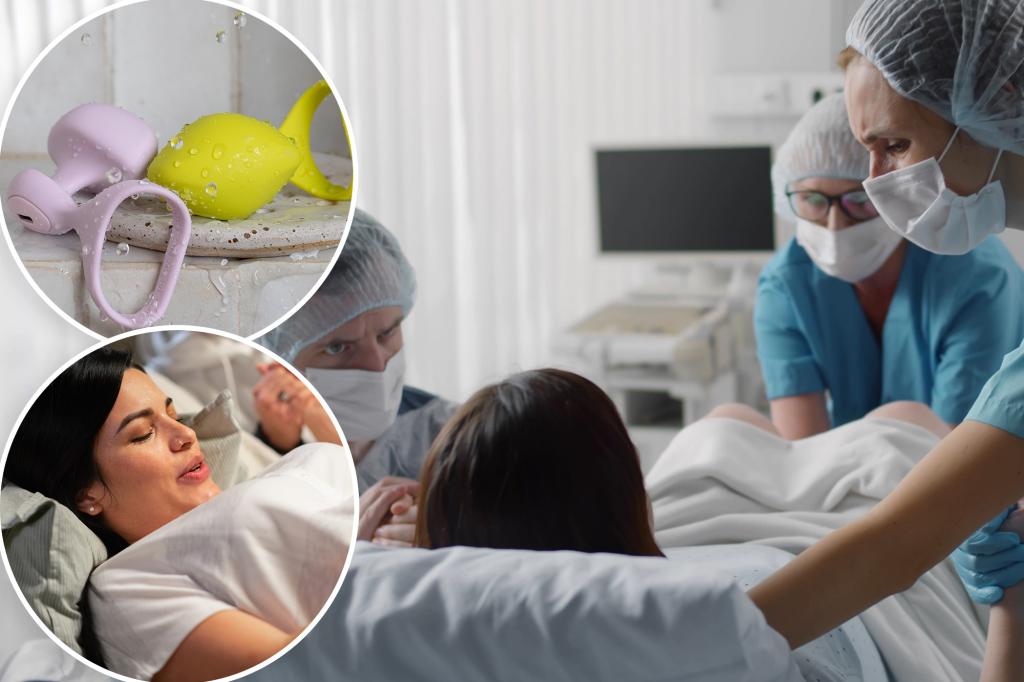Did you ever think, “Lamaze is great, but it sure could be sexier?”
With contractions, hospital lighting, guttural screams and a chorus of people urging you to push, childbirth is not typically billed as a pleasurable experience, let alone an orgasmic one.
But two companies are coming together — ahem — to change that.
Female-founded sexual wellness brand Dame has partnered with Orgasmic Birth® to launch a vibrator meant to be used during pregnancy, labor and birth — because they say a little “O” can make the experience much better, both by reducing pain with oxytocin and by reframing birth as an empowering and even pleasurable milestone.
The Fin PleasureVibe, $49, is a wearable finger vibrator, offers “gentle, external stimulation, which Dame CEO Alexandra Fine said makes it “discreet and intuitive, whether at home or in a hospital setting.”
“That’s the power of it: It gives people the choice to bring comfort and pleasure into their birth if they want to,” she told The Post.
“Although it is rarely part of the mainstream narrative around labor, orgasmic birth is a real possibility,” she went on. “We’re expanding awareness of a story that’s rarely told and giving people permission to imagine a fuller spectrum of birth experiences.”
There are plenty of moms out there who might be thinking: Who exactly would want to masturbate during childbirth? In fact, Fine herself wasn’t into it.
“I’ll be honest — my own birth experience wasn’t conducive to pleasure at all (a crowded hospital room full of people doesn’t exactly invite orgasm),” she admitted.
But a 2024 survey found that one in three women expressed interest in exploring self-pleasure during labor — and it would seem the benefits of getting off while pushing through are myriad.
“Labor and birth move through the cervix and vagina, touching the many nerves of the clitoral complex.”
Orgasmic Birth founder Debra Pascali-Bonaro
One pregnancy coach who teaches women to climax during labor says an orgasm can be 10 times stronger than morphine.
“Research shows that orgasm can reduce pain, increase pleasure and enhance the release of oxytocin,” Orgasmic Birth founder Debra Pascali-Bonaro told The Post.
“Oxytocin drives the contractions of labor and birth and is also the hormone of love and bonding, which helps reduce fear. Together, these effects create greater comfort, connection and relaxation, supporting the body’s natural ability to birth a baby gently and joyfully.”
What is “orgasmic birth,” exactly?
“Orgasmic birth” is a broad term and doesn’t actually hinge on reaching climax, Pasalli-Bonaro noted.
“Most people feel natural waves of sensation when pushing a baby into the world,” she explained.
“Nature’s design of rhythmic waves facilitates ease and safety in birth. These heightened sensations are often described as a feeling of power, what we call orgasmic birth, with or without an actual orgasm.”
But she acknowledges that for many, the idea of anything sexual during labor may feel uncomfortable.
“We are not used to talking about pleasure in childbirth or even about the anatomy of pleasure. Yet labor and birth move through the cervix and vagina, touching the many nerves of the clitoral complex,” she said.
Still, that doesn’t mean this is the right course of action for every mom to be.
“That is completely OK,” she said. “The message is simply to invite each woman to discover what makes them feel good.
“Self-pleasure is an evidence-based tool for reducing pain, creating relaxation, and fostering empowerment. For some, that may mean touch, while for others it may be loving words, music, movement, or meditation.”
What you need to get started
A 2021 review in the British Journal of Midwifery found that a private environment, careful choice of painkillers, sex-positive birth attendants and education are key to being able to have an orgasmic birth.
For those interested in exploring it, Pasalli-Bonaro recommends having open dialogue with your birth team.
“Ask them how they feel about pleasure and self-pleasure as a holistic tool for childbirth,” she advised.
“Discuss your need to feel private, safe, and to have time alone or with your partner. If your medical team is unfamiliar with these concepts, there is scientific evidence available to aid you in your discussions.”
Closer to delivery, she suggests preparing the environment in ways that support “birth ambience.” These sensory choices can include dim lighting, soothing scents and music, shifts that can be particularly impactful in a hospital setting.
“If it feels right, invite gentle touch, warm water, breathing practices, or movement,” she said. “For some, a vibrator or other pleasurable touch may be supportive. Trust your instincts, set the mood that feels right for you, and let go of any sense of performance.”
She also recommends using a doula, who can ensure your privacy.
Whether people choose to explore pleasure during birth or not, it is Pasalli-Bonaro’s hope that the experience is rooted in respect, confidence and connection.
“There is no right or wrong way to give birth,” she said
“This is about reclaiming birth as your own, trusting your body’s wisdom, and asking what you need to feel safe, supported, comfortable and at ease. Birth is about opening to love, to support, and to the amazing sensations our bodies are capable of creating. Trust in your power.”
Read the full article here


